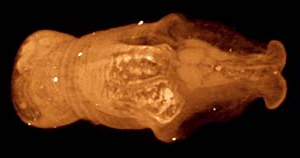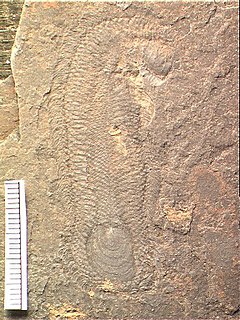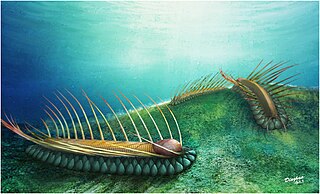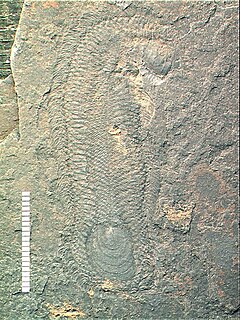
A sclerite is a hardened body part. In various branches of biology the term is applied to various structures, but not as a rule to vertebrate anatomical features such as bones and teeth. Instead it refers most commonly to the hardened parts of arthropod exoskeletons and the internal spicules of invertebrates such as certain sponges and soft corals. In paleontology, a scleritome is the complete set of sclerites of an organism, often all that is known from fossil invertebrates.

Wiwaxia is a genus of soft-bodied animals that were covered in carbonaceous scales and spines that protected it from predators. Wiwaxia fossils – mainly isolated scales, but sometimes complete, articulated fossils – are known from early Cambrian and middle Cambrian fossil deposits across the globe. The living animal would have measured up to 5 cm (2 inch) when fully grown, although a range of juvenile specimens are known, the smallest being 2 millimetres (0.079 in) long.

Aplacophora is a monophyletic group of small, deep-water, exclusively benthic, marine molluscs found in all oceans of the world. All known modern forms are shell-less: only some extinct primitive forms possessed valves. The group comprises the two clades Solenogastres (Neomeniomorpha) and Caudofoveata (Chaetodermomorpha), which between them contain 28 families and about 320 species. The aplacophorans are traditionally considered ancestral to the other mollusc classes. However, the relationship between the two aplacophoran groups and to the other molluscan classes and to each other is as yet unclear.

The halkieriids are a group of fossil organisms from the Lower to Middle Cambrian. Their eponymous genus is Halkieria, which has been found on almost every continent in Lower to Mid Cambrian deposits, forming a large component of the small shelly fossil assemblages. The best known species is Halkieria evangelista, from the North Greenland Sirius Passet Lagerstätte, in which complete specimens were collected on an expedition in 1989. The fossils were described by Simon Conway Morris and John Peel in a short paper in 1990 in the journal Nature. Later a more thorough description was undertaken in 1995 in the journal Philosophical Transactions of the Royal Society of London and wider evolutionary implications were posed.
The Coelosclerithophorans are a polyphyletic group of organisms bearing hollow sclerites made of aragonite, and with an allegedly distinctive microstructure.

Insect wings are adult outgrowths of the insect exoskeleton that enable insects to fly. They are found on the second and third thoracic segments, and the two pairs are often referred to as the forewings and hindwings, respectively, though a few insects lack hindwings, even rudiments. The wings are strengthened by a number of longitudinal veins, which often have cross-connections that form closed "cells" in the membrane. The patterns resulting from the fusion and cross-connection of the wing veins are often diagnostic for different evolutionary lineages and can be used for identification to the family or even genus level in many orders of insects.

Orthrozanclus is a genus of sea creatures from the Middle Cambrian Burgess shale. Animals in this genus were one to two centimeters long, with spikes protruding from their armored bodies. The placement of this genus into a specific family is not universally accepted.

Halwaxiida or halwaxiids is a proposed clade equivalent to the older orders Sachitida He 1980 and Thambetolepidea Jell 1981, loosely uniting scale-bearing Cambrian animals, which may lie in the stem group to molluscs or lophotrochozoa. Some palaeontologists question the validity of the Halwaxiida clade.
The Chancelloriids are an extinct family of animal common in sediments from the Early Cambrian to the early Late Cambrian. Many of these fossils consists only of spines and other fragments, and it is not certain that they belong to the same type of organism. Other specimens appear to be more complete and to represent sessile, bag-like organisms with a soft skin armored with star-shaped calcareous sclerites from which radiate sharp spines.

Chrysomallon squamiferum, commonly known as the scaly-foot gastropod, scaly-foot snail, or sea pangolin, is a species of deep-sea hydrothermal-vent snail, a marine gastropod mollusc in the family Peltospiridae. This vent-endemic gastropod is known only from deep-sea hydrothermal vents in the Indian Ocean, where it has been found at depths of about 2,400–2,900 m (1.5–1.8 mi). C. squamiferum differs greatly from other deep-sea gastropods, even the closely related neomphalines. In 2019, it was declared endangered on the IUCN Red List, the first species to be listed as such due to risks from deep-sea mining of its vent habitat that also produce high-quality metal ores.
The small shelly fauna, small shelly fossils (SSF), or early skeletal fossils (ESF) are mineralized fossils, many only a few millimetres long, with a nearly continuous record from the latest stages of the Ediacaran to the end of the Early Cambrian Period. They are very diverse, and there is no formal definition of "small shelly fauna" or "small shelly fossils". Almost all are from earlier rocks than more familiar fossils such as trilobites. Since most SSFs were preserved by being covered quickly with phosphate and this method of preservation is mainly limited to the Late Ediacaran and Early Cambrian periods, the animals that made them may actually have arisen earlier and persisted after this time span.
Since 1990 there has been intense debate among paleontologists about the evolution in the Early Cambrian period of the "super-phylum" Lophotrochozoa, which is thought to include the modern molluscs, annelid worms and brachiopods, as well as their evolutionary "aunts" and "cousins".
Australohalkieria is an extinct genus of halkieriid from Australia and Antarctica.

Class Xenusia, the Xenusiids, represents the subset of lobopodian worms that fall in the stem-lineage of Onychophora. Their type genus is Xenusion. They have relatively large, annulated, cylindrical bodies. Their lobopod legs have tubercles at their bases. Some have large frontal appendages, although these may represent taphonomic artefacts. Their mouth is terminal or subterminal, and they are marine. They probably represent a grade rather than a clade.

The palaeoscolecids are a group of extinct ecdysozoan worms resembling armoured priapulids. They are known from the Lower Cambrian to the late Silurian; they are mainly found as disarticulated sclerites, but are also preserved in many of the Cambrian lagerstätten. They take their name from the typifying genus Palaeoscolex.
Sinosachites is a genus of 'halkieriid' known only from sclerites; these have internal chambers that are sub-perpendicular to the central canal, to which they are connected by narrow channels. The chambers are the same diameter, ~40 µm, as the longitudinal canals in Australohalkieria; their greater number and arrangement as lateral rather than longitudinal bodies reflects the greater size of the Sinosachites sclerites, which measure about 1–2 mm in length.
Thambetolepis is a dubious genus of sachitid halkieriid from the Cambrian. The genus Sinosachites may have been the same as Thambetolepis.
The camenellans, consisting of the genera Camenalla, Dailyatia, Kennardia, Kelanella and Lapworthella, are a group of Tommotiid invertebrates from the Cambrian period, reconstructed as sister to all others. They are known from isolated sclerites, but are believed to have a scleritomous, Halkieria-like construction.
Armilimax is an extinct genus of shell-bearing slug-like animal known from a single specimen found in an exposed portion of the Spence Shale in the Wellsville Mountains in Box Elder County, Utah. As such, its morphology is ambiguous; it bears a seemingly U-shaped gut and, at the opposite end of its body, a shell without an apex. It has been tentatively interpreted as resembling Halkieria, but it does not contain sclerites. It is the first of its kind in the Great Basin. Only one species is known: Armilimax pauljamisoni.









